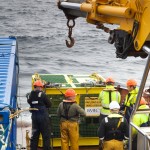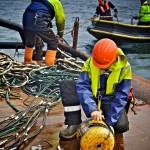Press release: World’s first real-time integrated environmental monitoring system at EMEC
EMEC’s novel sub-sea monitoring system successfully deployed
The European Marine Energy Centre (EMEC) has successfully recovered its novel Integrated Monitoring Pod following months of transmitting real-time data feeds from the seabed at the Fall of Warness tidal energy test site in Orkney, Scotland.
The first of its kind pre-commercial prototype is connected to the shore via a subsea cable to facilitate 24/7 real-time data collection, and has been delivering live data feeds back to EMEC which can be used by marine energy developers using the site.
The ongoing project is receiving funding from the Scottish Government via the Marine Renewables Commercialisation Fund (MRCF), which is managed by the Carbon Trust.
Scotland’s Energy Minister Fergus Ewing said:
“I am delighted that our £2.8 million innovation support programme, part of the Marine Renewables Commercialisation Fund, is funding EMEC’s integrated monitoring system. This has been successfully deployed at the Fall of Warness test site and highlights the role that such enabling technologies will play in the success of the first wave and tidal arrays.”
Angus Vantoch-Wood, Programme Manager of the MRCF at the Carbon Trust commented:
“The Carbon Trust is very pleased to be managing this innovative project and its ongoing delivery on behalf of the Scottish Government. It is really exciting to see EMEC’s novel Monitoring Pod solution being deployed and look forward to seeing the results, which we strongly believe will help to reduce the cost of early array deployments for both wave and tidal technologies.”
The bespoke system, designed by EMEC to operate in high velocity tidal flows, integrates a variety of sensors to undertake comprehensive concurrent environmental measurements, providing improved characterisation of high energy marine environments.
Making real-time data feeds available to developers will assist in device design, enable more accurate assessment of device performance, and support operations and maintenance planning.
“It was an incredibly exciting moment when we saw the first live data feeds coming through from the Pod” said Neil Kermode, EMEC’s Managing Director.
“Credit goes to the team here at EMEC as well as Leask Marine, Bryan J Rendall (Electrical), RM Computing, Numerical Business and J+S. The Pod was deployed in a highly volatile tidal environment, and we’re glad to have such a competent local supply chain with the combined experience, ingenuity and seamanship to make a tricky project like this run relatively smoothly. Having worked with these companies on many projects throughout the years makes the job a lot easier to manage.”
“There have been huge learning curves with this project as we’re operating in largely unchartered territory (even within the tidal energy industry), and we’ve learnt, and continue to learn, a great deal which will help support future developments of the Pod as well as other marine operations.”
“For example, we’ve found certain materials – connectors for instance – designed for offshore subsea operations are not necessarily suited to cope with the highly oxygenated and turbulent near-shore environment we are working in.”
The pod is set up as a plug-and-play prototype with the ability to install additional sensors as required, with future development focused on supporting data collection at commercial marine energy array projects.
EMEC have now recovered the Pod to carry out further inspections and enhancements prior to redeployment in spring 2016.
Mr Kermode added: “We’re keen to collaborate with the industry – particularly developers of sensors and those planning marine energy arrays – to drive the development of this Pod further and ensure that it fits the needs of all end users”.
Key lessons learnt throughout the design and deployment of the Pod have been highlighted in a complementary blog, available at: Blog: Integrated data collection in hostile environments
EMEC is now analysing the data that has been gathered by the Pod, and will provide further results from the project in early 2016.











